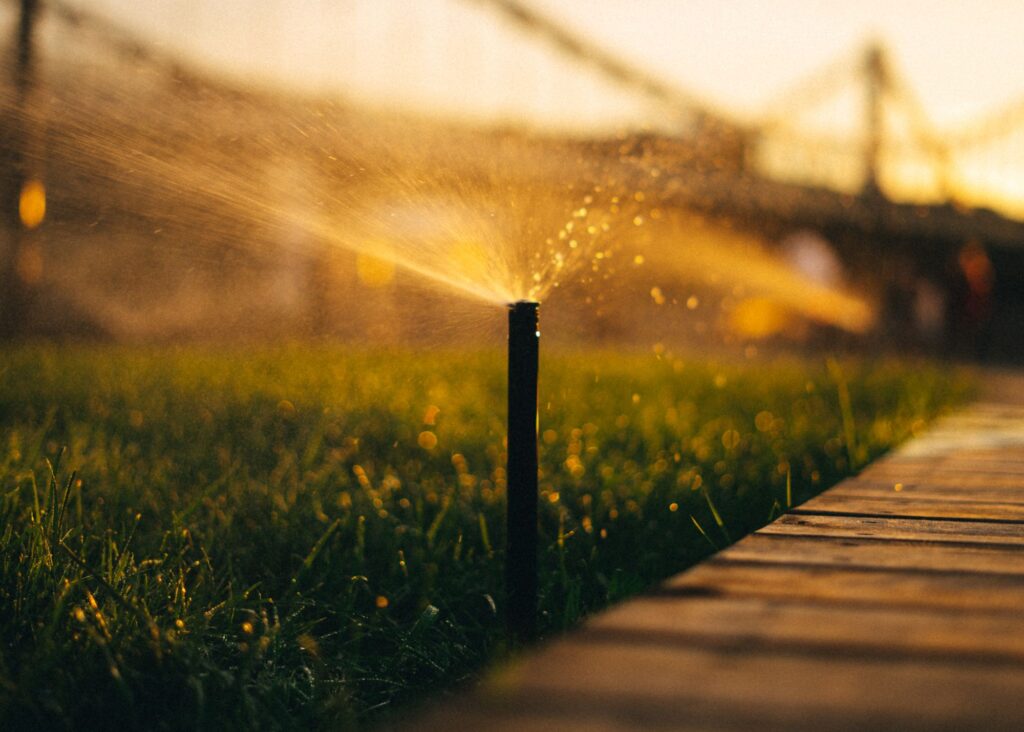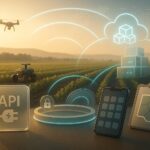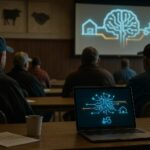Across a sun-scorched orchard in California’s Central Valley, a farmer checks her phone before dawn. Instead of guessing when to turn on the drip lines, she reads a concise recommendation generated by artificial intelligence: precisely how long to irrigate her almond trees today. This scene is increasingly common as a new wave of AI-powered irrigation systems takes root on farms. Agriculture accounts for about 70% of the world’s freshwater use, and with water scarcity looming across many regions, optimizing every drop has become both an economic and environmental imperative. Enter artificial intelligence – the latest farmhand – now helping growers decide when, where, and how much to water their crops with unprecedented precision.

At its core, AI-driven irrigation marries data from the soil and sky with advanced algorithms. Think of networks of soil moisture probes, weather stations, and even sensors on plants themselves, all feeding information into cloud-based “brain” systems. These systems analyze real-time inputs – soil moisture, weather forecasts, crop stage, historic usage patterns – to determine optimal irrigation schedules. The goal is to take the guesswork out of watering. On many American farms today, irrigation is still guided by intuition or tradition; only about one-third of farmers currently use quantitative methods to decide when and how much to irrigate, with most relying on simply checking the soil or using last year’s schedule as a guide. That antiquated approach can lead to overwatering or underwatering, wasting resources and stressing crops. AI aims to change that by crunching complex datasets into actionable advice. If it’s hotter and windier than usual, give the crops an extra drink; if rain is coming, hold off. As Justin Gibson, a product manager at irrigation firm Lindsay Corporation, explained: “What we can do on the prediction side is bring in a lot of different data streams that are relevant for irrigation scheduling… one of them is going to be weather”. By accounting for factors like forecasted heat or rain, AI-based tools can calibrate the next steps and even adjust to each farm’s unique conditions over time. In essence, these digital advisors learn the farm’s “rhythms,” combining farmer know-how with machine precision.
Table of Contents
TogglePhytech’s AI Advisor: A Coach for Every Crop
Against this backdrop, Israel-based agtech company Phytech has rolled out what it bills as the first-ever AI-powered irrigation advisor trained on live farm data. Phytech’s new AI Advisor represents a significant leap in marrying on-the-ground sensor networks with artificial intelligence for water management. What sets Phytech’s system apart is its rich data diet: it’s trained on real in-field measurements from the company’s extensive Internet of Things (IoT) network – including sensors that track tree growth, fruit expansion, soil moisture, and microclimate conditions. By learning from each farm’s plants, soil, and even the grower’s past irrigation decisions, the AI Advisor offers highly accurate, farm-specific watering recommendations in real time. In other words, the advice isn’t generic wisdom pulled from a textbook; it’s tailored to your orchard or field, on your soil, under your weather conditions.
Oren Kind, Phytech’s CEO, describes the system as a “super-intelligence that grows with their trees,” essentially a digital crop consultant that evolves alongside the farm. The AI Advisor continuously adapts to changing field conditions, closing the loop between monitoring and action. For years, farmers have been able to install sensors that tell them soil moisture or plant stress levels; the challenge was interpreting that flood of data and deciding what to do. Phytech’s new tool tackles this head-on by generating clear summaries and recommendations in natural language, effectively bridging the gap between raw data and irrigation execution on the ground. As Kind puts it, “we’re adding a super-agronomic intelligence, an army of advisors, to help tackle all the tough challenges farmers are facing. They will never grow alone again”.
What impact can such AI-driven advice have? Phytech’s platform is already credited with significant water savings and crop health improvements. In its recent sustainability report, Phytech revealed that farmers using its system in 2024 saved over 132 billion gallons of water – equivalent to the annual water consumption of more than 3.1 million U.S. households. Across 18,000 fields (spanning 402,000 acres and 43 million trees worldwide), these growers saw plant “water stress” plummet by 94%, a 20% improvement over typical industry benchmarks. This kind of reduction in crop stress means healthier plants and potentially better yields. Real-world users underscore the benefits: in Arizona’s arid ranches, one farm manager reported saving 316 million gallons of water in a single year thanks to Phytech’s recommendations. In California’s citrus groves, another manager uses the Phytech app daily like a doctor checking vital signs – tracking tree stress and adjusting the week’s watering schedule on the fly. By listening to what the plants “feel” (Phytech’s dendrometer sensors literally measure tiny expansions in trunk diameter to gauge plant thirst), farmers can respond before a wilt or wither sets in. This proactive approach not only conserves water but also bolsters productivity. “Maximizing yields, minimizing waste” is quickly becoming more than a slogan – it’s measurable reality when AI is in the irrigation loop.

An Ecosystem of Smart Water Innovations
Phytech may be grabbing headlines, but it’s far from the only player infusing irrigation with intelligence. In fact, the past two years have seen a flurry of innovation from both startups and legacy agricultural companies, all vying to help farmers water smarter. The smart irrigation market is on a rapid rise – valued around $1.8 billion in 2024 and projected to reach $3.0 billion by 2029 – fueled by an 11% annual growth rate as water conservation becomes a global priority. This boom has yielded an ecosystem of tools catering to different crops, geographies, and farm sizes.
On the high end, traditional irrigation equipment giants are adding AI to their toolkits. Lindsay Corporation, known for its center-pivot sprinklers dotting Midwestern cornfields, has upgraded its FieldNET Advisor platform with advanced analytics to simplify farmers’ irrigation decisions. Backed by 50+ years of crop and irrigation research, FieldNET’s AI crunches millions of agronomic data points to tell a grower when, where, and how much to irrigate each section of a field. The newest version rolled out in 2024 emphasizes whole-farm water management and real-time data integration, which Lindsay says boosts the system’s return on investment for users. FieldNET’s strength lies in pairing with physical irrigation hardware: farmers can get its recommendations on their smartphone and remotely start a pivot or drip system with a tap. Similarly, competitor Valmont Industries has been integrating AI into its Valley Irrigation equipment, and smaller players like Reinke are developing “smart” controllers for their pivots, signaling an industry-wide trend. These companies recognize that offering just iron and steel isn’t enough in the age of analytics – today’s farmers want intelligence layered on top of infrastructure.
Meanwhile, drip irrigation leaders are also jumping in. Netafim, the Israeli pioneer of drip systems, recently partnered with startup Treetoscope to embed live plant sensors into drip irrigation networks. In a pilot in Turkey, this combo of real-time plant “thirst” sensing with automated drip control significantly improved water savings and crop monitoring, leading Netafim to plan expansion of the technology into North and South America in 2025. The idea is that instead of irrigating on a fixed schedule or even a soil moisture reading, the drip system would respond to the plants’ actual needs in real time – essentially giving crops a voice to say “we need a drink now” or “we’re quenched.” This is the same principle Phytech uses in orchards, now applied to row crops and vegetables.
Startups around the globe are also driving change. New Zealand-based CropX has developed a platform that combines data from its proprietary soil sensors with satellite weather inputs and AI algorithms to fine-tune irrigation. The results are striking: users of the CropX system have been able to reduce irrigation water by up to 50% while maintaining or even improving crop yields. In Australia and New Zealand trials, CropX effectively halved water use without hurting productivity – a huge win in drought-prone farming areas. Another innovator, SupPlant (also from Israel), is tailoring AI irrigation advice for smallholder farmers in emerging markets. Rather than expensive hardware, SupPlant leverages an affordable sensor package and cloud-based AI to send simple watering instructions via a basic mobile app, helping farmers in Africa and Asia conserve water in staple crops. This focus on accessibility – low-cost tech and an intuitive app – aims to democratize AI irrigation so that it’s not just large, wealthy farms that benefit, but also 1-acre plots in Kenya or family farms in India.
Even agtech companies better known for crop monitoring or drones are jumping into irrigation advice. Arable, a maker of all-in-one weather-and-crop sensors, and satellite imagery firms are pairing up with irrigation services to predict crop water needs from above. IBM’s weather AI and NASA’s OpenET data (which estimates evapotranspiration via satellite) have been integrated into some farming dashboards to guide regional water planning. All these efforts point to a common theme: harnessing diverse data streams – from below ground, on the field, and high above – and translating them into smarter water use on the farm.
Downstream Effects: Yields, Costs and Conservation
The promise of AI-powered irrigation is not just about saving water (though that is itself critical in places like California’s Central Valley or the High Plains Ogallala aquifer region). It’s also about boosting farmers’ bottom lines and achieving environmental sustainability. Done right, precision watering can be a rare win-win: use less water, grow more crop. Field results and early studies are encouraging. For instance, some vineyards in California have reported yield increases on the order of 15-20% after adopting AI-guided irrigation, all while cutting water use by a similar 20%. Other farms have seen even bigger jumps. One almond grower cited in industry reports saw a 30% reduction in water usage with no loss in yield by using sensor-based scheduling, and a Midwestern operation using advanced monitoring achieved a 20% yield bump by eliminating under-irrigation in drier parts of its fields. While results vary by crop and climate, the consensus is that more precise control of water generally leads to healthier plants – avoiding the twin scourges of water stress and waterlogging, both of which can stunt growth. Crops that get the right drink at the right time are less prone to stress-related diseases and can put more energy into grain fill or fruit development. In the long run, that means higher productivity per acre.
There are direct economic gains too. Water is money: every acre-foot pumped from a well or pulled from a canal has a cost, whether in electricity for pumps or fees to irrigation districts. So, shaving water use by 20-50% can significantly lower operating costs for farms, especially as energy prices and water tariffs rise. In addition, many states are enacting stricter limits on agricultural water draw (California’s Sustainable Groundwater Management Act, for example), so technologies that help farmers stay within quotas and avoid penalties have a regulatory compliance value. AI systems can also stagger water usage to off-peak times. In 2024, fully 90% of Phytech-monitored irrigation events occurred during off-peak energy hours, cutting energy costs and reducing strain on the grid during peak air-conditioning season. By avoiding midday pumping when electricity is expensive, farmers save on their utility bills. Moreover, using less water often translates to using less fertilizer and other inputs inefficiently – overwatering can leach nutrients out of the root zone, so preventing that waste saves input costs and benefits water quality downstream.
From an environmental standpoint, the ripple effects of smarter irrigation are profound. Pumping less water conserves groundwater and leaves more in rivers for ecosystems and downstream users. Precision application also means less runoff; when you’re not drenching fields beyond what the soil can absorb, you prevent excess fertilizer from washing into waterways. Studies have noted that smart irrigation can cut water use by 40-70% and significantly reduce harmful runoff, keeping nutrients in the soil and protecting local ecosystems. There’s a carbon angle too: less pumping and less treatment of water means lower carbon emissions. One analysis found that large-scale smart irrigation adopters saw notable energy savings – IoT-based systems have slashed energy use by up to 30% in some cases – which directly translates to fewer greenhouse gas emissions from power plants. For companies tracking their sustainability metrics, these reductions are increasingly important. Not to mention, consumers and food companies are starting to pay attention to how much water goes into that pint of almonds or that bottle of wine; “water footprint” might soon join “carbon footprint” in the lexicon of sustainable farming, and AI can help shrink it.
Crucially, the benefits also tie back to resilience. With climate change making weather more erratic, farms that can dynamically adjust irrigation to each season’s pattern – or even each week’s pattern – are less vulnerable to droughts or heatwaves. AI can’t make it rain, but it can help a farmer eke the most out of whatever water is available, and guide them to avoid the devastation of running a well dry or wilting a crop. In the U.S. Midwest, where the massive Ogallala Aquifer is being depleted, such efficiency gains could help extend the life of groundwater resources that corn and wheat belts depend on. In the Southwest and California, they could be the difference between maintaining agricultural productivity or seeing more farmland fallowed.
Irrigation Intelligence or Irrigation Inequity?
For all its promise, however, the AI irrigation revolution faces real-world hurdles. Farming is a conservative industry by necessity – crops don’t suffer fools gladly – and many growers eye new tech with justified caution. High-tech irrigation systems, bristling with sensors and algorithms, can be expensive to install and maintain. In fact, high cost is the number one barrier cited by North American farmers when it comes to adopting new farm technology, with 52% calling cost a major challenge and 40% citing unclear return on investment. An AI advisor subscription, plus the hardware and connectivity to support it, can run thousands to tens of thousands of dollars upfront. While proponents point out that the typical payback period for sensor-based irrigation systems is around 1.5 to 2 years, that is still a hefty leap of faith for a farmer on a thin margin – especially if the benefits (in yield or savings) aren’t guaranteed in year one. Smaller farms, in particular, may find it hard to justify the investment without subsidies or proven case studies from similar operations.
There’s also the challenge of integrating these shiny new digital tools with the rustic reality on many farms. A significant share of U.S. farms still use decades-old irrigation infrastructure: analog gauges, manual valves, and center pivots that might not have cellular modems or fancy controllers. Upgrading a whole system or retrofitting IoT devices onto old equipment can be daunting. It’s no surprise that 40% of farmers express concerns about compatibility between smart irrigation tech and their existing farm equipment. Nobody wants to invest in a platform that won’t “play nice” with their pumps or tractors. Some companies are addressing this by designing modular add-ons (for example, small telemetry boxes that can bolt onto an old pump to connect it to the cloud), but the patchwork nature of farm setups means one size rarely fits all. Until standards and interoperability improve, this patchwork will be a barrier.
Connectivity is another sticking point. While rural internet access has improved, it’s hardly universal. About 85% of U.S. farms now have internet access, but only half of those have adequate broadband connectivity, which many advanced AI applications require for transmitting data or running cloud-based analyses. If your fields have spotty cell service, the fanciest AI irrigation app is of little use when it can’t phone home. This is gradually changing with initiatives to expand rural broadband and the advent of satellite internet options, but for now, connectivity gaps can make high-tech solutions unreliable in exactly the remote locations that might need them most.
Then there’s the human factor – perhaps the most understated challenge. The average American farmer is nearing 60 years old, and many have been irrigating successfully for decades based on experience and intuition. Convincing them to trust a digital advisor over their own eyes (or their neighbor’s advice) takes time. Early generations of farm tech didn’t help; clunky software and overhyped “precision ag” tools in the 2000s and 2010s left some farmers with a sour taste, skeptical of new promises. Gaining farmer trust means AI tools today must be easy to use and demonstrably reliable. That’s why many companies are focusing on simple smartphone interfaces and clear recommendations rather than black-box complexity. As one irrigation expert noted, if the AI’s suggestion consistently matches what a seasoned farmer would have done anyway, the grower gains confidence and starts to lean on it more. It’s a gradual courtship between tradition and technology.
Data ownership and privacy also lurk in the background. AI thrives on data – potentially even pooling data from many farms to improve its models. But independent growers can be wary of sharing detailed farm information with tech providers or government agencies, fearing that data about their water use or yields might be used against them (for example, by regulators or markets). Clear agreements and farmer data rights will need to be established to ensure comfort with these systems. In essence, the agtech industry must prove it’s a partner, not a spy.

The Future: Every Drop Counts
Despite the challenges, the direction is clear: agriculture is steadily embracing the digital drip by drip. In water-stressed areas of the United States – from California’s Central Valley to the High Plains of Kansas and Nebraska – AI-driven irrigation is moving from experimental to essential. Economic pressures (the need to reduce input costs and maximize yields) and environmental mandates (to conserve scarce water and curb waste) are together driving this change. And as the technology matures, it’s also becoming more accessible. The cost of sensors continues to drop, user interfaces are getting more farmer-friendly, and knowledge is spreading. Many younger farmers and farm managers, armed with smartphones and comfortable with data, are emerging as “agtech champions” on their operations, persuading older generations to give these tools a shot.
It’s not an exaggeration to say we are witnessing the early days of a paradigm shift in how farms are run. Just as tractors mechanized labor in the 20th century, AI promises to digitize decision-making in the 21st – with irrigation management a prime early example. The new AI irrigation advisors are like a convergence of agronomy, meteorology, and hydraulics expertise delivered in real time to the palm of a farmer’s hand. They won’t replace the farmer’s skill and intuition, but they will augment them, acting as a tireless scout and number-cruncher in the field. With water resources growing tighter by the year and climate uncertainties ahead, such tools could well become as common as the moisture meter or the irrigation pump.
In the end, the measure of success will be tangible: can these AI systems help grow more food with less water, consistently and affordably? Early indicators say yes – from dramatic water savings to solid ROI within a couple seasons – but scaling those successes across millions of acres is the next challenge. Policymakers and industry leaders are beginning to take note, too, exploring cost-share programs and incentives for water-saving tech, much like they did for solar panels or efficient irrigation equipment in years past. The hope is that what might start as an edge innovation for high-value crops or large farms will trickle down (quite literally) to every farm, including small family farms that form the backbone of U.S. agriculture.
For now, in fields across America, the convergence of silicon and soil is yielding promising results. A lettuce grower on California’s Central Coast can sleep a bit easier knowing his AI scheduler will wake him if the field needs an urgent pre-dawn watering to stave off an impending heat wave. A Nebraska corn farmer, historically reliant on the fickle rain, can stretch his limited irrigation allotment further with data-guided precision, perhaps squeezing through a drought with a decent crop. These are not flashy changes, but incremental ones – more bushels here, millions of gallons saved there – adding up across the agricultural landscape. They represent technology directly in service of sustainability and productivity, not in an abstract way but in the very immediate sense of “Did we save water today? Did we grow good crops today?”
The rise of AI in agricultural water management is, at its heart, a story of pragmatism and hope. It’s about farmers – eternal optimists by trade – leveraging new tools to adapt to new realities. As one might say, the future of farming will require plenty of old-fashioned gumption, but it won’t hurt to have a little artificial intelligence in the mix. After all, every drop counts, and now we have algorithms to help make each drop count even more.




